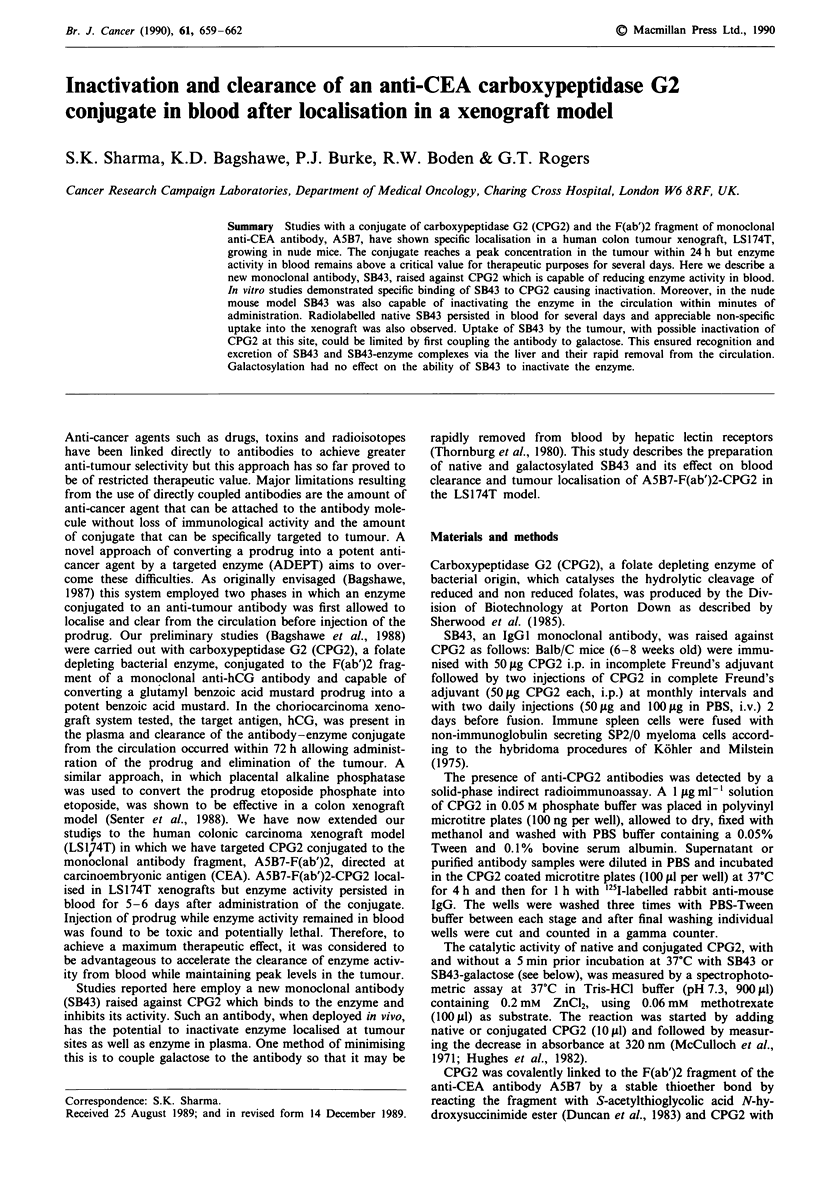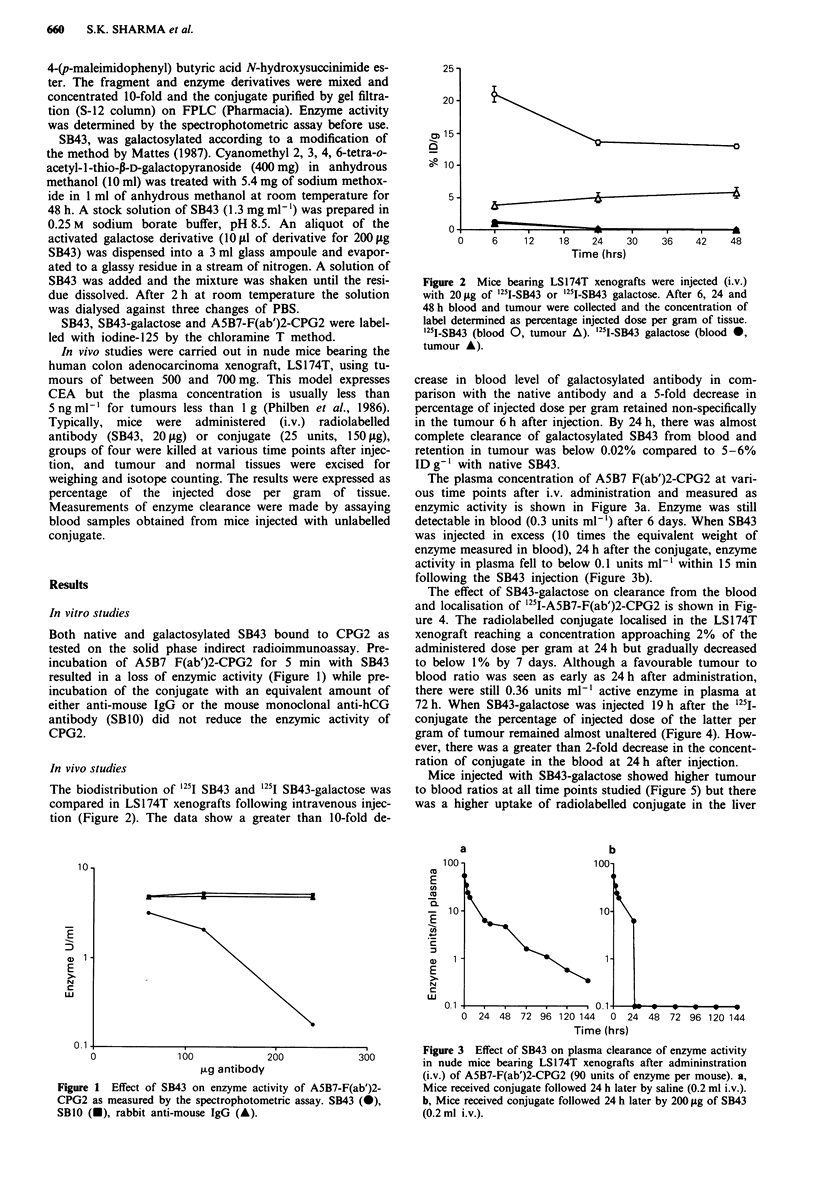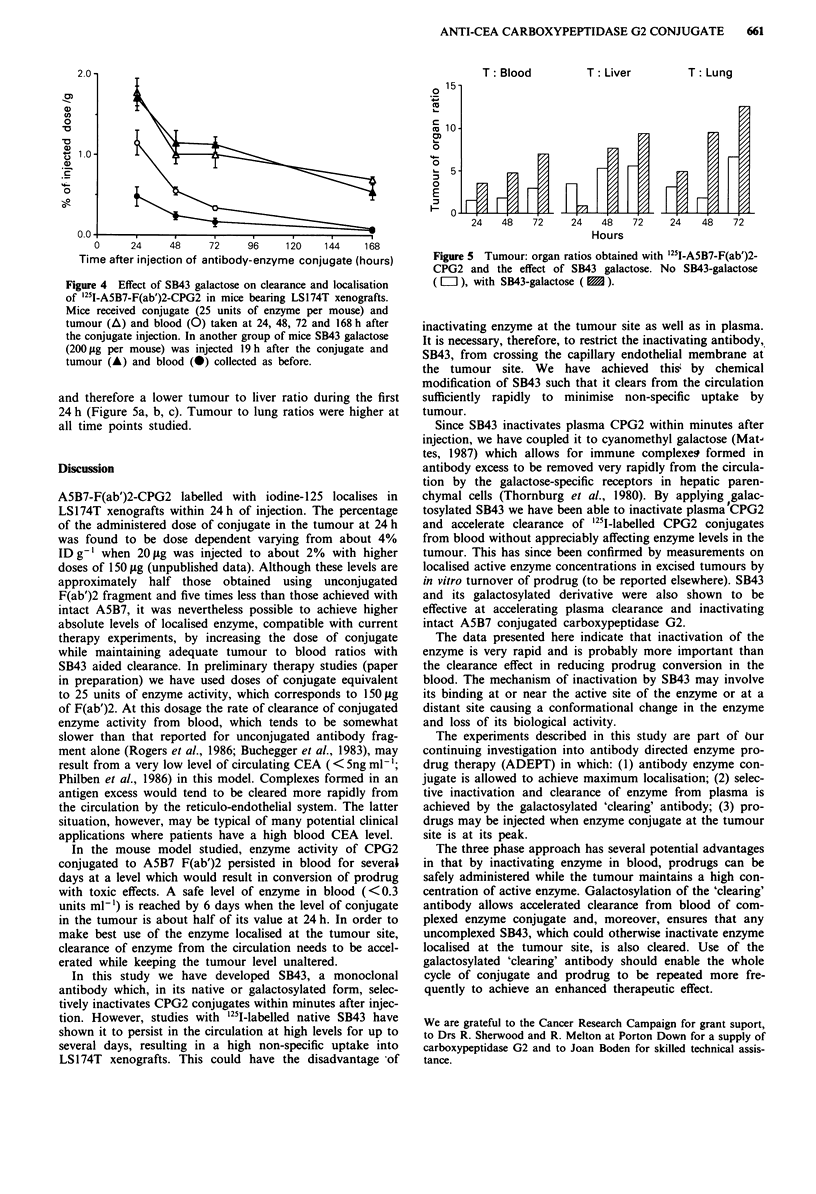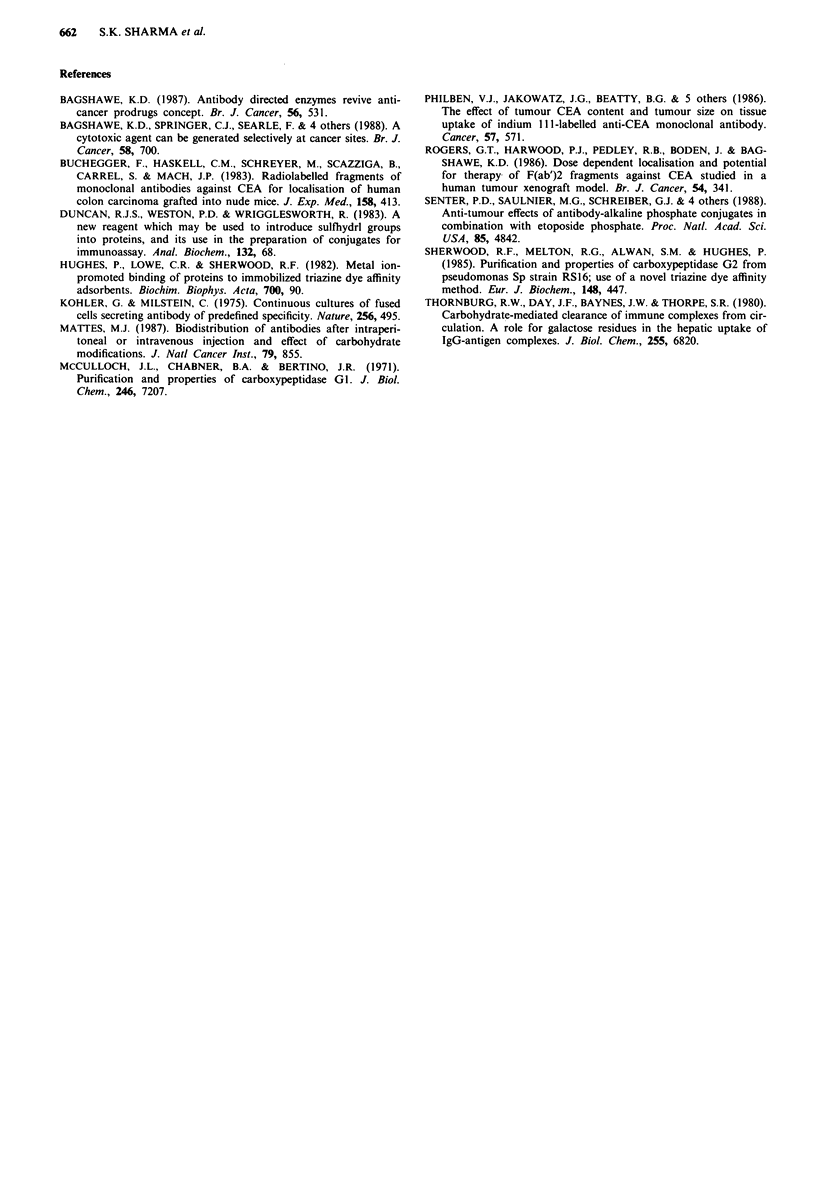Abstract
Studies with a conjugate of carboxypeptidase G2 (CPG2) and the F(ab')2 fragment of monoclonal anti-CEA antibody, A5B7, have shown specific localisation in a human colon tumour xenograft, LS174T, growing in nude mice. The conjugate reaches a peak concentration in the tumour within 24 h but enzyme activity in blood remains above a critical value for therapeutic purposes for several days. Here we describe a new monoclonal antibody, SB43, raised against CPG2 which is capable of reducing enzyme activity in blood. In vitro studies demonstrated specific binding of SB43 to CPG2 causing inactivation. Moreover, in the nude mouse model SB43 was also capable of inactivating the enzyme in the circulation within minutes of administration. Radiolabelled native SB43 persisted in blood for several days and appreciable non-specific uptake into the xenograft was also observed. Uptake of SB43 by the tumour, with possible inactivation of CPG2 at this site, could be limited by first coupling the antibody to galactose. This ensured recognition and excretion of SB43 and SB43-enzyme complexes via the liver and their rapid removal from the circulation. Galactosylation had no effect on the ability of SB43 to inactivate the enzyme.
Full text
PDF



Selected References
These references are in PubMed. This may not be the complete list of references from this article.
- Bagshawe K. D. Antibody directed enzymes revive anti-cancer prodrugs concept. Br J Cancer. 1987 Nov;56(5):531–532. doi: 10.1038/bjc.1987.237. [DOI] [PMC free article] [PubMed] [Google Scholar]
- Bagshawe K. D., Springer C. J., Searle F., Antoniw P., Sharma S. K., Melton R. G., Sherwood R. F. A cytotoxic agent can be generated selectively at cancer sites. Br J Cancer. 1988 Dec;58(6):700–703. doi: 10.1038/bjc.1988.293. [DOI] [PMC free article] [PubMed] [Google Scholar]
- Buchegger F., Haskell C. M., Schreyer M., Scazziga B. R., Randin S., Carrel S., Mach J. P. Radiolabeled fragments of monoclonal antibodies against carcinoembryonic antigen for localization of human colon carcinoma grafted into nude mice. J Exp Med. 1983 Aug 1;158(2):413–427. doi: 10.1084/jem.158.2.413. [DOI] [PMC free article] [PubMed] [Google Scholar]
- Duncan R. J., Weston P. D., Wrigglesworth R. A new reagent which may be used to introduce sulfhydryl groups into proteins, and its use in the preparation of conjugates for immunoassay. Anal Biochem. 1983 Jul 1;132(1):68–73. doi: 10.1016/0003-2697(83)90426-8. [DOI] [PubMed] [Google Scholar]
- Hughes P., Lowe C. R., Sherwood R. F. Metal ion-promoted binding of proteins to immobilized triazine dye affinity adsorbents. Biochim Biophys Acta. 1982 Jan 4;700(1):90–100. doi: 10.1016/0167-4838(82)90296-5. [DOI] [PubMed] [Google Scholar]
- Köhler G., Milstein C. Continuous cultures of fused cells secreting antibody of predefined specificity. Nature. 1975 Aug 7;256(5517):495–497. doi: 10.1038/256495a0. [DOI] [PubMed] [Google Scholar]
- Mattes M. J. Biodistribution of antibodies after intraperitoneal or intravenous injection and effect of carbohydrate modifications. J Natl Cancer Inst. 1987 Oct;79(4):855–863. [PubMed] [Google Scholar]
- McCullough J. L., Chabner B. A., Bertino J. R. Purification and properties of carboxypeptidase G 1 . J Biol Chem. 1971 Dec 10;246(23):7207–7213. [PubMed] [Google Scholar]
- Philben V. J., Jakowatz J. G., Beatty B. G., Vlahos W. G., Paxton R. J., Williams L. E., Shively J. E., Beatty J. D. The effect of tumor CEA content and tumor size on tissue uptake of indium 111-labeled anti-CEA monoclonal antibody. Cancer. 1986 Feb 1;57(3):571–576. doi: 10.1002/1097-0142(19860201)57:3<571::aid-cncr2820570329>3.0.co;2-b. [DOI] [PubMed] [Google Scholar]
- Rogers G. T., Harwood P. J., Pedley R. B., Boden J., Bagshawe K. D. Dose-dependent localisation and potential for therapy of F(ab')2 fragments against CEA studied in a human tumour xenograft model. Br J Cancer. 1986 Aug;54(2):341–344. doi: 10.1038/bjc.1986.183. [DOI] [PMC free article] [PubMed] [Google Scholar]
- Senter P. D., Saulnier M. G., Schreiber G. J., Hirschberg D. L., Brown J. P., Hellström I., Hellström K. E. Anti-tumor effects of antibody-alkaline phosphatase conjugates in combination with etoposide phosphate. Proc Natl Acad Sci U S A. 1988 Jul;85(13):4842–4846. doi: 10.1073/pnas.85.13.4842. [DOI] [PMC free article] [PubMed] [Google Scholar]
- Sherwood R. F., Melton R. G., Alwan S. M., Hughes P. Purification and properties of carboxypeptidase G2 from Pseudomonas sp. strain RS-16. Use of a novel triazine dye affinity method. Eur J Biochem. 1985 May 2;148(3):447–453. doi: 10.1111/j.1432-1033.1985.tb08860.x. [DOI] [PubMed] [Google Scholar]
- Thornburg R. W., Day J. F., Baynes J. W., Thorpe S. R. Carbohydrate-mediated clearance of immune complexes from the circulation. A role for galactose residues in the hepatic uptake of IgG-antigen complexes. J Biol Chem. 1980 Jul 25;255(14):6820–6825. [PubMed] [Google Scholar]


